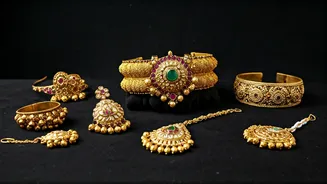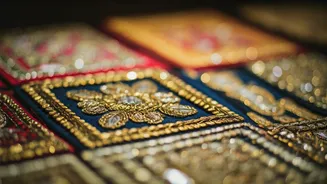Jadau: Gemstone Grandeur
Jadau jewelry, a hallmark of regal Indian craftsmanship, showcases the art of setting precious gemstones without the use of soldering. The technique, introduced
during the Mughal era, involves carefully placing gemstones within a gold framework and securing them with gold foil. The result is a seamless, opulent display of color and light. Often, Jadau pieces feature intricate enamel work on the reverse side, adding another layer of artistry and complexity. Jadau is especially prized in bridal jewelry, where it's seen as a symbol of status and tradition.
Polki: Uncut Diamond Majesty
Polki jewelry, another enduring style, uses uncut diamonds, which retain their natural brilliance and form. These diamonds are set on a base metal, frequently gold, and mounted with the front side open to maximize light reflection. This style provides an old-world charm and a radiant luster. Popular in traditional Indian weddings, Polki jewelry has a timeless appeal, often seen in necklaces, earrings, and bangles, where the diamonds' raw beauty is prominently displayed. Polki’s value derives from the rarity and quality of the uncut diamonds used.
Kundan: Setting Gemstones Artfully
Kundan jewelry is distinguished by its technique of setting gemstones using pure gold. This method involves meticulously shaping gold foil to secure the gems, creating a seamless and lustrous finish. The process necessitates a high degree of skill and precision. Kundan designs often involve elaborate patterns and settings, showcasing gemstones such as rubies, emeralds, and sapphires, set to their best advantage. The result is jewelry that's rich in detail and timeless in elegance, very popular in India.
Meenakari: Enameling Excellence
Meenakari jewelry combines gemstones with vibrant enamel work, adding colorful detailing to gold or silver pieces. The enamel is applied to the surface of the jewelry, often depicting floral motifs, geometric patterns, or mythological scenes. The process involves multiple firings at high temperatures to set the enamel. Meenakari is often used on the reverse side of Jadau or Kundan pieces, and it contributes to the jewelry's overall beauty and value. Its vibrant and intricate designs make it a beloved choice for special occasions.
Filigree: Woven Metal Art
Filigree is a delicate art form involving the use of fine metal wires, usually gold or silver, to create intricate lace-like designs. These wires are meticulously twisted, coiled, and soldered onto a base structure to form elaborate patterns. Filigree jewelry often features openwork designs that capture light and create a sense of ethereal beauty. It reflects the meticulous skill of the artisan. This style offers a sense of lightness and grace, making it a popular choice for earrings, pendants, and other adornments.
Thewa: Glass-Based Glamour
Thewa jewelry showcases the art of fusing intricately designed gold sheets onto colored glass. The technique, originating from Rajasthan, involves skilled artisans delicately creating designs on gold sheets and then fusing them onto glass with heat. The result is jewelry with stunning visual contrast and depth. The designs frequently portray historical scenes, mythological figures, and nature, often capturing a sense of narrative. Each piece of Thewa jewelry is a unique work of art, with a high degree of detail and skill involved in its creation.
Navratna: Nine-Gem Marvel
Navratna jewelry, meaning "nine gems" in Sanskrit, incorporates nine gemstones, each representing a planet in Vedic astrology. This combination includes ruby (sun), pearl (moon), red coral (mars), emerald (mercury), yellow sapphire (jupiter), diamond (venus), blue sapphire (saturn), hessonite garnet (rahu), and cat's eye chrysoberyl (ketu). The gemstones are typically set in a specific order, believed to bring harmony and balance to the wearer. Navratna jewelry is considered auspicious, representing good health, prosperity, and overall well-being. Its use is deeply rooted in Indian culture.











